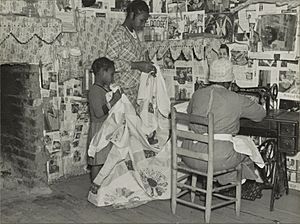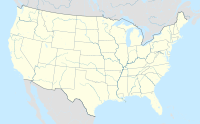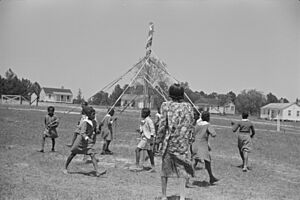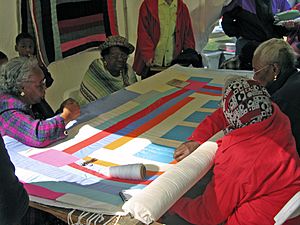Boykin, Alabama facts for kids
Quick facts for kids
Boykin, Alabama
|
|
|---|---|

Rear view of the detached kitchen and former plantation home of the Mark Pettway family, called Sandyridge, in Boykin April 1937. The house was demolished a short time later. Photographed by Arthur Rothstein.
|
|

Location of Boykin in Wilcox County, Alabama.
|
|
| Country | United States |
| State | Alabama |
| County | Wilcox |
| Area | |
| • Total | 2.81 sq mi (7.27 km2) |
| • Land | 2.79 sq mi (7.24 km2) |
| • Water | 0.01 sq mi (0.03 km2) |
| Elevation | 128 ft (39 m) |
| Population
(2020)
|
|
| • Total | 208 |
| • Density | 74.42/sq mi (28.73/km2) |
| Time zone | UTC-6 (Central (CST)) |
| • Summer (DST) | UTC-5 (CDT) |
| ZIP code |
36723
|
| Area code(s) | 334 |
| FIPS code | 01-08680 |
| GNIS feature ID | 154993 |
Boykin, also known as Gee's Bend, is a small community in Wilcox County, Alabama. It is mostly made up of African American residents. The community is located in a big curve of the Alabama River.
In 2020, about 208 people lived here. The Boykin Post Office opened in 1949 and still serves the area today.
Gee's Bend got its name from Joseph Gee. He was an early landowner who moved here in 1816. He brought 18 enslaved African Americans with him to start a cotton farm.
Contents
About Boykin, Alabama
Boykin is a piece of land almost surrounded by the Alabama River. It sits in a horseshoe-shaped bend of the river called Gee's Bend. This area is part of the Black Belt of Alabama.
A Look at Its Past
After Joseph Gee passed away, his farm and 47 enslaved people went to his nephews. In 1845, they sold the land to their relative, Mark H. Pettway. The Pettway family moved from North Carolina to Gee's Bend with about 100 enslaved people.
When slavery ended, many of the formerly enslaved people continued to work on the Pettway farm. They became sharecroppers, meaning they farmed the land and shared their crops with the landowner. Many people photographed in Gee's Bend during the 1930s were named Pettway. The white Pettway family owned the land until 1895. Then, a lawyer named Adrian Sebastian Van de Graaff bought it. He managed the farm from far away.

In the 1930s, reports showed how isolated the community was. The ferry from the east was not reliable, and the road from the west was often muddy. The community received help from the Red Cross and the government.
Starting in 1935, a government agency called the Resettlement Administration began helping. They gave loans to farmers and offered advice on farming and managing homes. They also helped build houses, barns, a school, and a sawmill. They even encouraged people to use mules instead of oxen for farm work.
In 1937, the agency bought the old Pettway farm and two other farms. This was over 10,000 acres of land. They divided the land and rented it to 92 families. A nurse started working in the community in 1938. Construction began on a school, a store, a blacksmith shop, and a cotton gin.
By 1939, things had improved a lot. Many families in Gee's Bend bought their farms from the government in the 1940s. They paid about $1,400 for each farm. This was much less than what the government had paid for the land.
In 1941, a professor named Robert Sonkin visited Gee's Bend. He recorded music, stories, and discussions from the community.
The Ferry Story

Gee's Bend became important during the Civil Rights Movement in the 1960s. The community started the Freedom Quilting Bee. This group helped families earn money by selling handmade quilts. It also helped the community grow.
Many residents started taking the ferry to Camden, the county seat, to register to vote. Because of this, local officials stopped the ferry service in 1962. This meant people had to drive for more than an hour to get to Camden. The people of Gee's Bend did not have ferry service for 44 years.
In the 1990s, Congress set aside money for a new ferry. But the project had problems. Finally, in 2006, a new ferry was ready. The ferry service started again on September 18, 2006. By 2020, the ferry could carry up to 15 cars and 132 passengers. It now uses electric motors and batteries that recharge at the docks.
- Link to Google Maps showing routes between Camden and Gee's Bend
Famous Quilts

The quilts made by the women of Gee's Bend became very famous. In 2002, an exhibit of their quilts opened at the Museum of Fine Arts, Houston. The show then went to the Whitney Museum in New York City. Their art was called "some of the most miraculous work of art America has produced."
The exhibit traveled to many other museums. The women who made the quilts became well-known. They traveled to talk about their community and their art. For the first time, many of them earned real money from their work. Their success helped to bring their community back to life.
In 2006, the United States Postal Service released a sheet of ten commemorative stamps. These stamps showed images of Gee's Bend quilts.
Quilters and Their Rights
In 2007, some quilters from Gee's Bend filed lawsuits. They said that some dealers were wrongly claiming to own the rights to their quilts. They also said their names and images were used without permission to sell products.
Other quilters in the community were not happy about these lawsuits. They felt that some members were trying to act on their own. A judge later dismissed the lawsuits.
Notable people
- Robert Petway, a blues singer and guitarist
Images for kids
See also
 In Spanish: Boykin (Alabama) para niños
In Spanish: Boykin (Alabama) para niños







